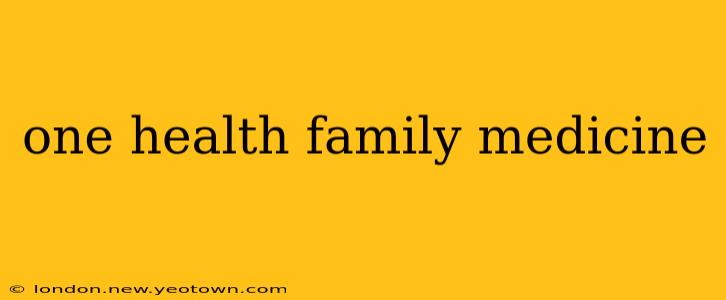Imagine a world where your family doctor understands not just your body, but the intricate web of connections between your health, your environment, and the health of your community. That’s the promise of One Health – a revolutionary approach to healthcare that’s rapidly transforming family medicine. Forget the siloed approach of treating individual symptoms; One Health recognizes that human health is inextricably linked to the health of animals and the environment. This holistic perspective is reshaping how we approach preventative care, disease treatment, and overall well-being.
Let's embark on a journey to understand this exciting paradigm shift in family medicine.
What is One Health Family Medicine?
One Health family medicine transcends the traditional model by integrating human, animal, and environmental health into a unified approach. It recognizes that diseases like zoonotic infections (diseases that jump from animals to humans), foodborne illnesses, and even mental health issues are often influenced by environmental factors and animal interactions. This interconnectedness requires a collaborative effort between medical professionals, veterinarians, environmental scientists, and public health officials.
Instead of treating a symptom in isolation, a One Health family physician considers the broader context:
- Environmental factors: Is the family exposed to pollutants or contaminated water? Does their neighborhood lack access to green spaces?
- Animal interactions: Are there pets in the home? Does the family work with animals? Are there potential vectors for diseases in the community?
- Social determinants of health: Factors such as poverty, access to quality food, and social support systems significantly impact health outcomes.
By examining these factors, a One Health practitioner can provide more comprehensive and effective care.
How Does One Health Impact Family Medicine Practice?
The integration of One Health principles is reshaping family medicine practices in several crucial ways:
- Proactive disease prevention: By understanding environmental risks and animal-human interactions, practitioners can implement more targeted preventative strategies. This might include recommending vaccinations, promoting healthy food choices based on local environmental factors, or advising on safe animal handling practices.
- Improved diagnosis and treatment: Considering the interconnectedness of health systems leads to more accurate diagnoses. For example, understanding the role of climate change in the spread of infectious diseases aids in early intervention and treatment.
- Enhanced patient education: One Health practitioners empower patients to become active participants in their own health and the health of their communities. This means educating patients about environmental sustainability, responsible pet ownership, and the importance of preventing zoonotic disease transmission.
- Strengthened community partnerships: One Health necessitates collaboration with diverse stakeholders, including veterinarians, environmental agencies, and community organizations, creating a stronger safety net for community health.
What are the Benefits of One Health Family Medicine?
The advantages of adopting a One Health approach are far-reaching:
- Improved population health: By addressing the root causes of diseases, rather than merely treating symptoms, One Health contributes to a healthier population overall.
- Reduced healthcare costs: Proactive prevention measures often reduce the need for expensive treatments later on.
- Enhanced patient experience: Holistic care that addresses multiple factors often leads to more satisfied and engaged patients.
- Strengthened global health security: The collaborative nature of One Health makes us better prepared to address emerging infectious diseases and other global health challenges.
What are Some Examples of One Health in Action?
Let’s look at a few scenarios illustrating the power of One Health:
- A family doctor noticing a rise in Lyme disease cases in a specific area might collaborate with local veterinarians and environmental agencies to identify potential tick habitats and implement control measures.
- A practitioner counselling a patient with asthma might consider air quality in their neighbourhood and recommend strategies for reducing exposure to air pollutants.
- A doctor treating a child with a foodborne illness might work with public health officials to trace the source of the contamination and prevent further outbreaks.
These examples demonstrate how One Health goes beyond individual patient care to impact the entire community.
What are the Challenges in Implementing One Health Family Medicine?
While the potential benefits of One Health are significant, implementing this approach faces challenges:
- Interprofessional collaboration: Requires overcoming communication barriers and fostering collaboration between various healthcare professions.
- Data integration: Collecting and analyzing data from multiple sources (human, animal, environmental) poses logistical hurdles.
- Funding and resources: Significant investment is necessary for training, research, and data infrastructure.
How Can I Find a One Health Family Doctor?
The adoption of One Health principles is still relatively new, but its growing popularity suggests that more physicians are integrating this approach into their practices. Look for physicians who explicitly mention their commitment to One Health in their online profiles or through their practice descriptions. Also, contacting local public health departments or veterinary organizations may lead you to practitioners using a One Health framework.
The future of family medicine is holistic, and One Health is paving the way for a healthier and more sustainable future for all.

